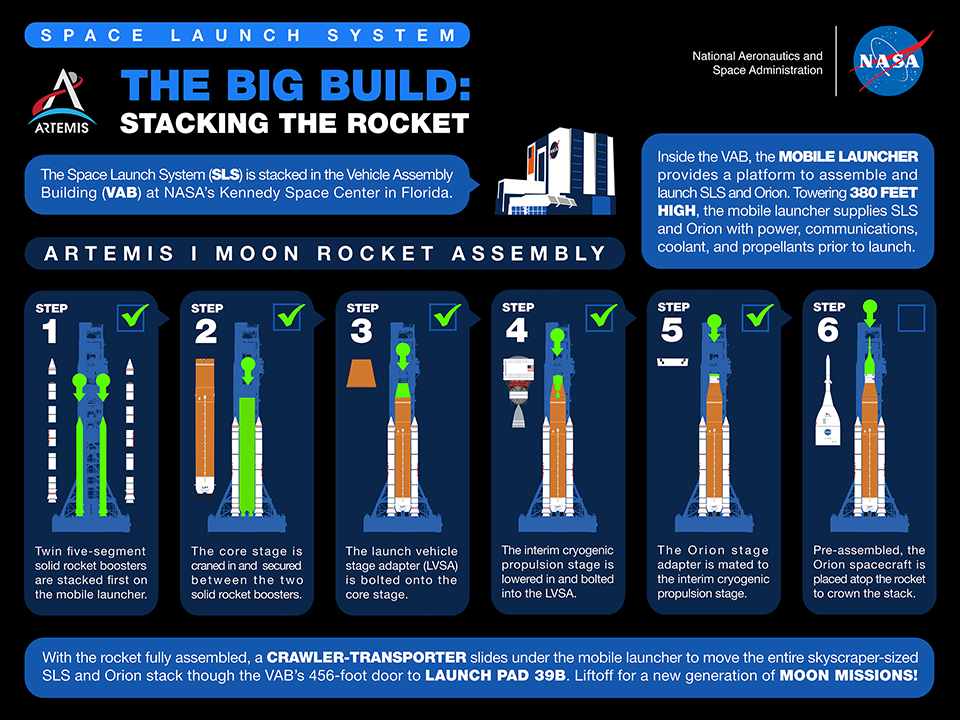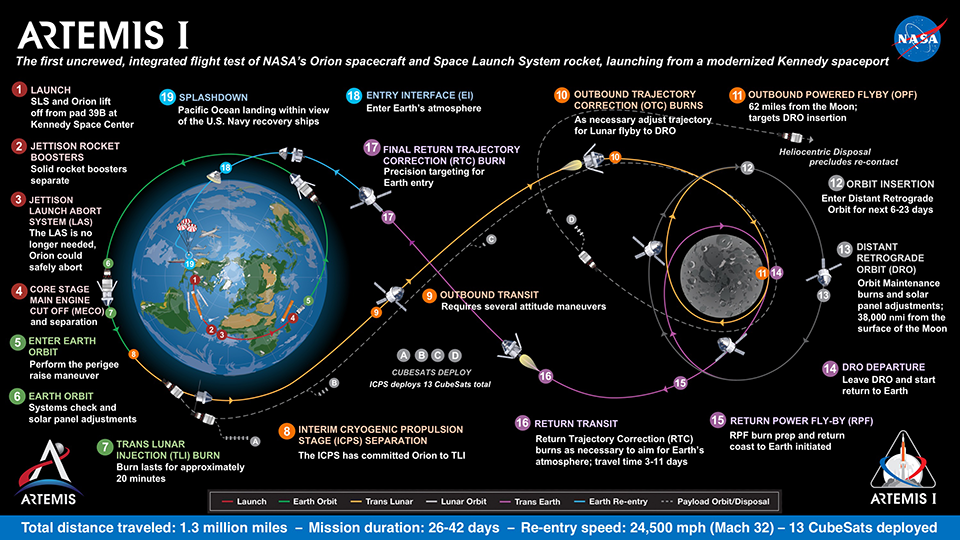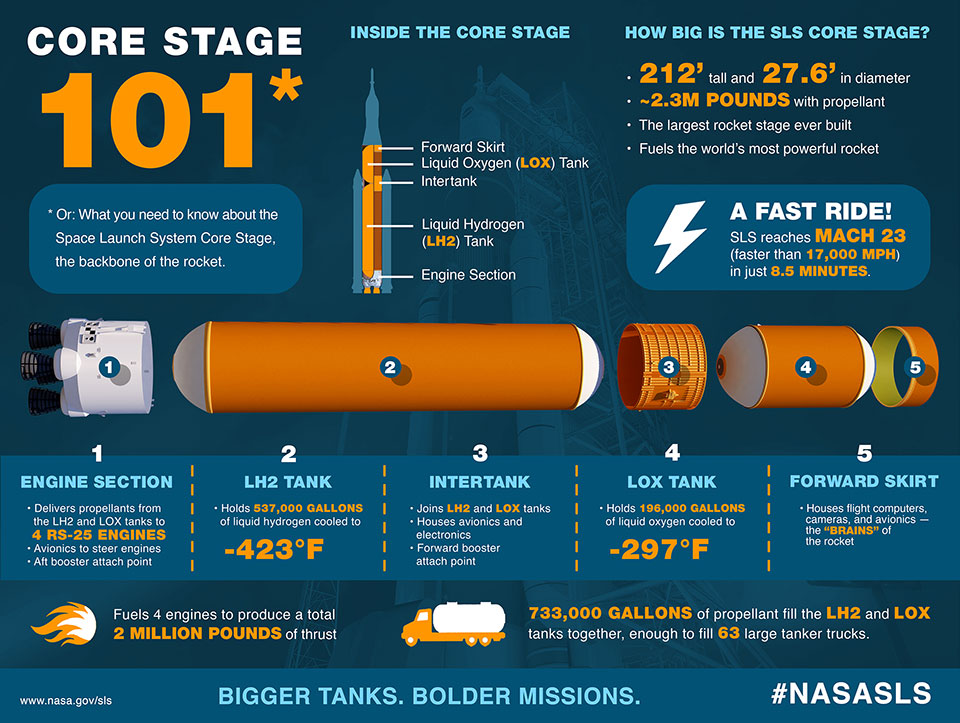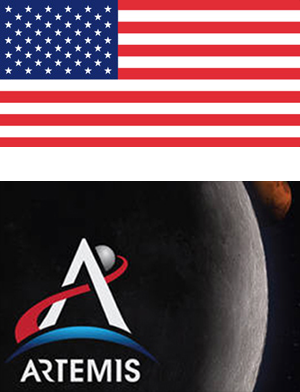Advanced Rocketry Not Landing Back on Launch Pad
Rocket to the Moon, Mars and Beyond
Boeing people and products have powered giant leaps in human space exploration over the past five decades. Now, with the NASA Artemis program — named after Apollo's twin sister — Boeing will be part of landing the first woman and first person of color on the moon and the sustainable exploration of more of the lunar surface than ever before. What NASA and its commercial and international partners learn on and around the moon will enable astronauts to take the next giant leap — all the way to Mars. NASA's Space Launch System (SLS) is the technologically advanced, heavy-lift rocket that will get us there.
Boeing is the prime contractor for the design, development, test and production of the launch vehicle core stage and upper stages, as well as development of the flight avionics suite. The Boeing-built core stage for the Artemis I mission has completed a series of tests known as Green Run at the agency's Stennis Space Center in Mississippi. It has been refurbished and delivered to Kennedy Space Center in Florida for integration with the rest of SLS. Meanwhile, Boeing is building the core stages for Artemis II and III.
Click the + icons to learn more about the different components that form the Space Launch System.
Built by Boeing Built by non-Boeing supplier
Orion Spacecraft
Launched on SLS, the Orion spacecraft will serve as the exploration vehicle that will carry up to four crew members to space, provide emergency abort capability, sustain the crew during multiweek missions and provide a safe reentry to Earth from deep space return velocities. It's composed of a crew module, service module and launch abort system.
Built by Lockheed Martin | NASA/Radislav Sinyak photo

ICPS
The Interim Cryogenic Propulsion Stage (ICPS) for SLS Block 1 is the initial configuration that can deliver 27 metric tons of payload to the moon. Based on the proven Delta Cryogenic Second Stage and powered by one Aerojet Rocketdyne RL10 engine, ICPS will propel an uncrewed Orion spacecraft to fly beyond the moon and back on the Artemis I mission.
Built by United Launch Alliance and Boeing | NASA/Ben Smegelsky photo

LVSA
The Launch Vehicle Stage Adapter (LVSA) connects the Block 1 core stage to the upper stage while providing structural, electrical and communication paths. It separates the core stage from the second stage that includes astronauts in the Orion crew vehicle. The cone-shaped adapter is roughly 30 feet in diameter by 30 feet tall. The LVSA consists of 16 aluminum-lithium 2195 alloy panels.
Built by Teledyne Brown Engineering | NASA/Fred Deaton photo

Forward Skirt
As the brains of SLS, the forward skirt is responsible for the rocket reaching its destination. It houses flight computers, cameras and avionics — the routers, processors, power, other boxes and software that control stage functions and communications. Along with the liquid oxygen tank and the intertank, it makes up the top half of the core stage.
Built by Boeing | NASA/Eric Bordelon photo

LOX Tank
The liquid oxygen (LOX) tank holds 196,000 gallons (742,000 liters) of liquid oxygen cooled to minus 297 degrees Fahrenheit. Its thermal foam coating protects it from extreme temperatures — the cold of the propellants and the heat of friction. A test article at NASA's Marshall Space Flight Center in 2020 was subjected to 170% maximum predicted flight loads — far beyond the pressures of liftoff and launch — before rupturing and spilling 197,000 gallons (746,000 liters) of water across the test stand.
Built by Boeing | NASA photo

Intertank
Joining the LH2 and LOX tanks, the intertank houses avionics and electronics that will control the rocket in flight. It also anchors two massive solid rocket boosters. The avionics units on the SLS core stage work with the flight software to perform various functions during the first eight minutes of flight. Some control the navigation, some communicate with the Orion spacecraft and some control how the engines perform. The intertank makes up the top half of the core stage, along with the LOX tank and forward skirt.
Built by Boeing | NASA/Jude Guidry photo

Solid Rocket Boosters
The largest human-rated solid rocket boosters ever built for flight, the SLS twin boosters stand 17 stories tall and burn about six tons of propellant every second. Each booster generates more thrust than 14 four-engine jumbo commercial airliners. Together, the SLS twin boosters provide more than 75% of the total thrust at launch.
Built by Northrop Grumman | NASA/Scott Mohrman photo

LH2 Tank
The liquid hydrogen (LH2) tank comprises two-thirds of the core stage, weighs 150,000 pounds (68,000 kilograms) and holds 537,000 gallons (2 million liters) of liquid hydrogen cooled to minus 423 degrees Fahrenheit. Thermal foam keeps the LH2 at the right temperature and pressure. A test article structurally identical to the flight hardware at NASA's Marshall Space Flight Center in 2019 withstood more than 260% of expected flight loads over five hours before buckling.
Built by Boeing | NASA/MAF/Steven Seipel photo

Engine Section
In addition to its miles of cabling and hundreds of sensors, the engine section is a crucial attachment point for the four RS-25 engines that work with two solid rocket boosters to produce a combined 8.8 million pounds of thrust at liftoff. Avionics here steer the engines, too. It was built vertically and flipped to horizontally to connect with the LH2 tank.
Built by Boeing | NASA photo

RS-25 Engines
Four RS-25 engines will deliver more than 2 million pounds of thrust at altitude. Combined with two five-segment solid rocket boosters, the propulsion system will give SLS about 8.8 million pounds of thrust at launch — more lift than any current rocket and 15% more than the Saturn V. An RS-25 variant is under production for Artemis missions past the first four.
Built by Aerojet Rocketdyne | Aerojet Rocketdyne photo

Path to the Pad
After the first SLS core stage successfully completed its Green Run hot fire test, teams at Stennis Space Center refurbished it, removed it from the B-2 test stand, and sent it to Kennedy Space Center for integration and launch. Inside Kennedy's iconic Vehicle Assembly Building, NASA and industry teams will stack the different elements of the rocket on top of its mobile launcher. The building and the mobile launcher have been specially outfitted to accommodate SLS and the Orion spacecraft.

See how the Artemis I core stage was prepared for delivery from Stennis to Kennedy.
Feature Stories


A Space Launch System guide to the galaxy
October 21, 2021 in Space
NASA's Space Launch System, or SLS, was designed and built by American industry to be a super-heavy-lift, deep space rocket, able to open the solar system and interstellar space to human exploration.
Learn More

Artemis, part 2
August 25, 2021 in Space
The 2nd Space Launch System rocket's core stage advances in Louisiana as its in-space stage arrives in Florida.
Learn More


Uplifting Progress on Artemis I
June 16, 2021 in Space
NASA's Exploration Ground Systems team has lifted the Boeing-built core stage onto the Space Launch System mobile launcher, ready for stacking with the other rocket elements.
Learn More

























Tuning up for Green Run
April 28, 2020 in Space
Boeing and NASA Space Launch System teams have completed a rigorous avionics review so the program will be prepared to resume testing of the first SLS core stage when NASA reopens Stennis Space Center.
Learn More

Building a Core Capability for NASA
April 6, 2020 in Space
At Michoud Assembly Facility, all elements of the SLS core stage for the crewed Artemis II lunar mission have been welded and built, and the third core stage was being fabricated before a suspension of operations in response to COVID-19.
Learn More





Boeing Begins Engine Install on SLS Core Stage
October 23, 2019 in Space
Boeing and Aerojet Rocketdyne technicians are installing the four powerful RS-25 engines modified for the Space Launch System at NASA's Michoud Assembly Facility, while ramping up to support the full core stage hot fire testing at Stennis Space Center next year.
Learn More

Fresh ideas from the factory floor
October 10, 2019 in Space
Innovation is built into the Space Launch System from the ground up, as technicians and engineers work together to improve the rocket by incorporating ideas from the shop floor into future design and build plans, making each rocket core stage come together faster, and more efficiently.
Learn More



Testing the Limits
August 27, 2019 in Space
Space Launch System liquid oxygen and liquid hydrogen tanks undergo testing at Marshall Space Flight Center to ensure the rocket can withstand launch and ascent.
Learn More

More than a Rocket
August 8, 2019 in Space
As Boeing prepares for final element join on the first Space Launch System core stage, the second core stage of the advanced launch system is underway, and the design of a powerful Exploration Upper Stage is taking shape.
Learn More

Full Throttle for Rocket Production
May 31, 2019 in Space
The second of three major joins that make up the Space Launch System core stage is underway in New Orleans, taking America a giant leap closer to launching NASA's Artemis missions.
Learn More




Monumental Journey
December 2, 2016 in Space
Space Launch System employees move closer to completing core stage of world's most powerful rocket.
Learn More

Far Out
February 3, 2014 in Space
Boeing's next big adventures into deep space ride with new super rocket.
Learn More

The Path to Mars: Deep Space Mission
December 4, 2014 in Innovation, Space
NASA is setting its eyes on the exploration of Mars, an over two year-long journey that will make history. Today's children will be the first explorers of our neighboring planet with help from Boeing technology to discover ground humans humans have yet to see.
Learn More

The Rocket Makers
November 19, 2014 in Space
With cutting-edge technology, Boeing employees once again are helping build a mighty rocket.
Learn More

38 Stories of Power
November 13, 2014 in Innovation, Space
With cutting-edge technology, Boeing employees once again are helping build a mighty rocket.
Learn More


Tanks for a great idea
March 18, 2014 in Space, Technology
Boeing has designed and built two composite liquid-hydrogen fuel tanks for heavy-lift launch vehicles that will propel future air and space missions.
Learn More

Missions
SLS will launch a permanent human presence in deep space. Its flexibility and evolvability will support diverse exploration, science and security missions.
On the Artemis I test flight, SLS will launch an uncrewed Orion spacecraft to the moon to test the performance of the integrated system. Additional missions are planned with this NASA SLS Block 1 configuration and its 27 metric ton launch payload capability to Trans-Lunar Injection (TLI) beyond Earth orbit, as the even more powerful Block 1B version is designed and built. This upgraded two-stage configuration will provide NASA with lift capability of 42 metric tons to TLI beyond Earth orbit, using the Boeing-built Exploration Upper Stage. That's almost three times the lift power to TLI as any other rocket.
Boeing has delivered flight hardware for the first Artemis mission and is producing flight hardware for Artemis II and beyond.

Learn more about Space Launch System mission capability.
Core Stage 101

Videos
Space Launch System Gallery
Space Launch System Customer

NASA is Boeing's customer for the core stage, upper stages and flight avionics of Space Launch System — America's rocket — which will support the Artemis moon missions and make the next generation of human spaceflight possible.
Boeing is committed to NASA's Artemis program and to the National Space Council's vision for continued American leadership and international partnerships in space.
The Boeing SLS Program is managed out of the company's Space and Launch division in Huntsville, Alabama, and employs Boeing's workforce in Huntsville, at NASA's Michoud Assembly Facility in New Orleans, and at other Boeing sites and with suppliers across the country. The Boeing Exploration Launch Systems office supports NASA on strategy and policy for Space Exploration programs procured by the NASA Marshall Space Flight Center.
Advanced Rocketry Not Landing Back on Launch Pad
Source: https://www.boeing.com/space/space-launch-system/